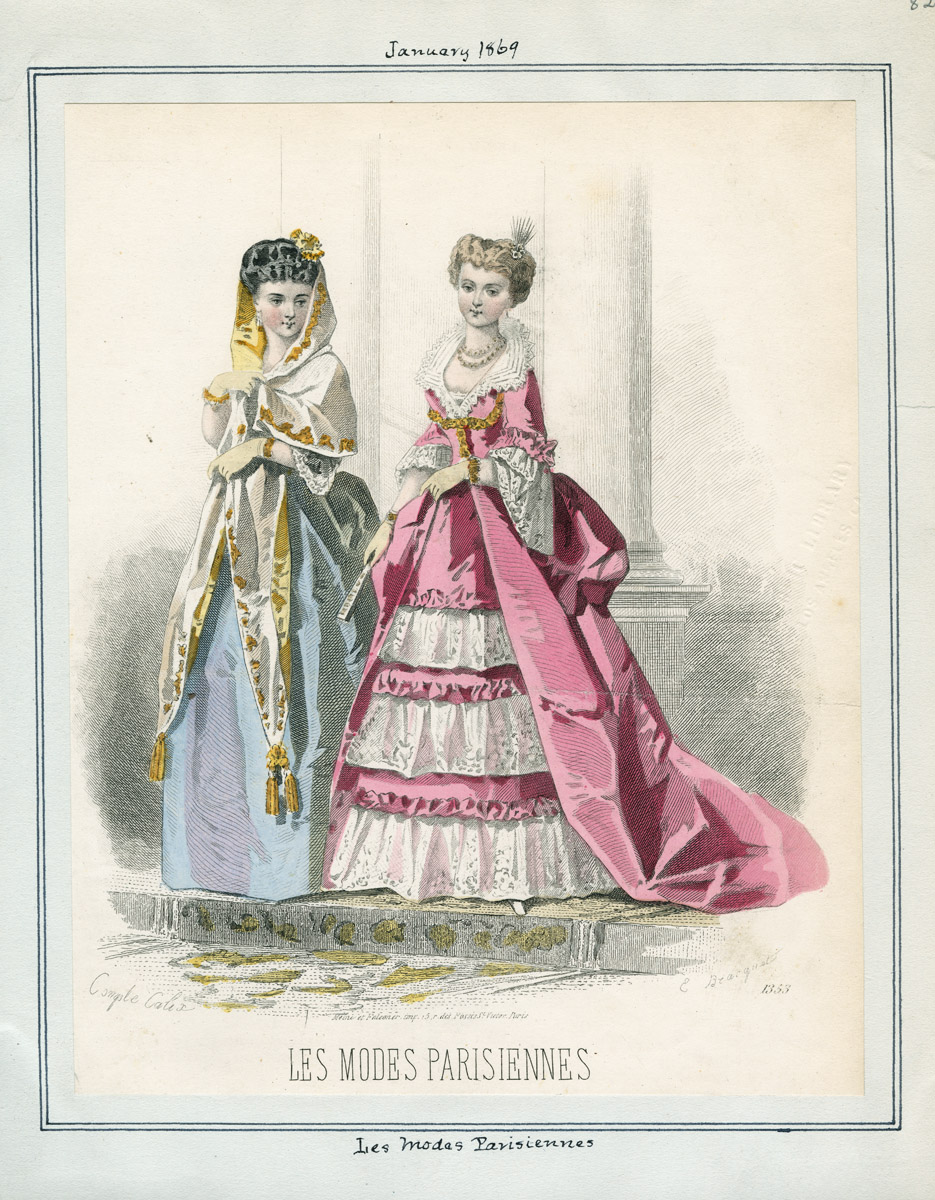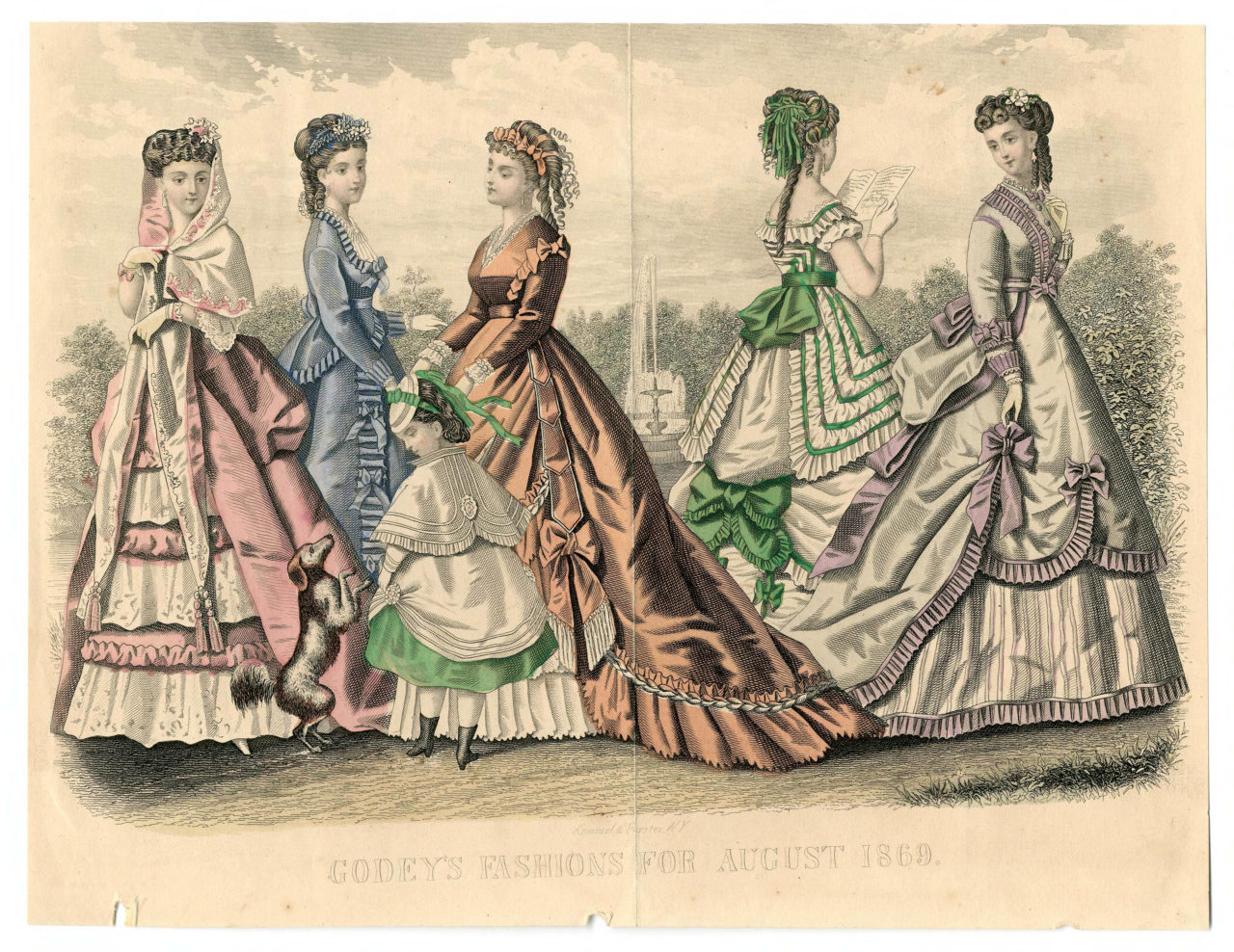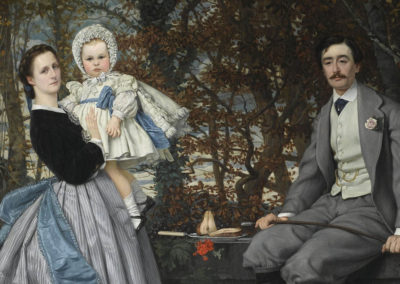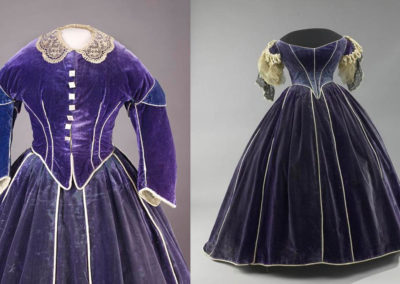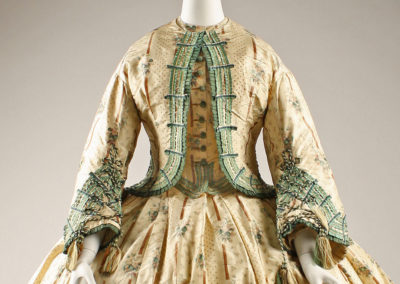OVERVIEW
In 1869, women were beginning to wear bustled silhouettes, often with trains. Bright synthetic dyes continued to be popular and a taste for 18th-century revival elements like the polonaise was growing.
Womenswear
T
he year 1869 marked a moment of transition in fashionable dress. Fashion moved away from the crinoline and made its first steps towards the bustle. Narrower skirts were topped with overskirts and aprons, some in the form of panniers. But as we will see, 1869 begins with a small revival of old fashions (Fig. 1); in the January “New York Fashions” column subtitled “Ball Toilettes,” a Harper’s Bazar columnist wrote:
“The present revival of the styles of the last century is nowhere so plainly seen as in the fanciful ball toilettes of the winter. Many of the dresses now worn are copied in detail from the costumes of the time of Louis XV. A few years ago this picturesque array was only seen at masquerades and fancy-dress balls. Now many ladies make a careful study of old French pictures, and, with the assistance of a skillful seamstress, fashion their own evening dresses in imitation thereof, sure that they will be in the prevalent mode.” (51)
Highlighting the changing tide in skirts, in March 1969, the British journal World of Fashion, commented:
“In commencing our observations on the Spring Fashions of 1869, we would first state that one of the greatest changes that has taken place since last season is the adoption of the Panier style of looping up (…)” (1)
Then, the following month, a World of Fashion writer discussed skirt styles at length, describing a particular skirt and how it formed a large ‘bouffant’ (1) all around the waist. This style—the bustle—grew in popularity during 1869, edging out the crinoline (Fig. 2).
In The Peterson Magazine “Fashions for August” column, one writer commented:
“With regard to the make of dresses, we are glad to say that no change has taken place, for so numerous have been the new styles lately, that the fashion would almost change between the time a lady took her dress to her dress-marker and got it sent home. Short dresses for street wear, for both old and young; short dresses for the morning for the young; long dresses for afternoon, or visiting, seems to be the rule. But the make of these is so varied, and when not too exaggerated, the looped and puffed skirts are so bewitching that one never tires of them.” (157)
Fig. 1 - François-Claudius Compte-Calix (French, 1813-1880). Les Modes Parisiennes, January 1869. Los Angeles: Los Angeles Public Library. Source: Los Angeles Public Library
Fig. 2 - Gandin (Italian). Fashion plate, February 1869. New York: The Metropolitan Museum of Art - Watson Library, Record no. b17509853. Gift of Woodman Thompson. Source: The Metropolitan Museum of Art - Watson Library
Fig. 3 - Artist unknown (American). Godey's Fashions, August 1969. New York: Metropolitan Museum of Art - Watson Library, Record no. b17509853. Gift of Leo Van Witsen. Source: Metropolitan Museum of Art - Watson Library
Fig. 4 - Charles-Édouard Boutibonne (French, 1816–1897). Getting Dressed, 1869. Oil on canvas. Private collection. Source: 1000 Museums
These variations in dresses (Fig. 3 and 4) were quite impressive design-wise; but in the context of 1869, none were as new or definitive as the movement towards the bustle (Fig. 5).
The exploration and experimentation with color occurred throughout the 1860s and 1870s, as dyes became more available and popular. Aniline dyes were invented in the mid-nineteenth century which made it possible for designers to create garments in brighter colors than ever before (Fig. 6).
Fig. 5 - Maker unkonwn (American). Ensemble, ca. 1869. Silk. New York: Metropolitan Museum of Art, 1984.594a–d. Gift of Deane and Sydney Litwalk, 1984. Source: Metropolitan Museum of Art
Fig. 6 - M. Vignon (French). Dress, ca. 1869-70. Ribbed silk trimmed with satin, faced with cotton, brass. London: Victoria & Albert Museum, T.118 to D-1979. Source: Victoria & Albert Museum
Fig. 7 - William Powell Frith (British, 1819-1909). The Two Doves, 1869. Oil on canvas; 58.5 x 44.5 cm. Private Collection. Source: Bonhams
In 1869, English artist William Frith produced a painting of a young woman with her face half-turned to the viewer, holding a dove on her right hand (Fig. 7). She wears a white dress with small decorative lavender flowers printed on the fabric, and it is paired with a large lavender bow at the waist that cascades down the back of her dress. There is a small presence of a potential bustle here, but it is definitely nowhere close to those seen in other examples. The ruffled neck is delicate and precise, meant to highlight the woman’s facial structure, youth, and beauty. The soft drapery at the wrists allows for her hands to move freely, and the material creates a feeling of wispiness and gentleness. The strong and powerful lavender bow serves as a contrast to the white fabric of the dress, accentuating both the woman’s waist and how small it is; and also as a means to draw attention to her as a whole. The painting reflects the changes in waist-skirt designs, as well as the use of brighter colors by designers. Compared to the other dresses of 1869 (like the reference images on this page), we can see that the dress worn in this Frith painting is quite subdued and far less intricate than the others; this dress most likely belonged to a bourgeois woman as it’s quite decorative to an extent, but not enough to be worn by an upper-class woman. It serves more as an everyday dress. Moreover, the simple headband and humble dove downplay any extravagance this dress may have presented otherwise.
The corset (Fig. 8) remained a mainstay in women’s fashion as the undergarment of choice; it kept dresses structured and it kept women’s bodies looking ‘prim and proper’ in them. Likewise, wedding dresses were still a white or cream color (Figs. 9 and 10).
Fig. 8 - Worcester Skirt Company (American, 1861–1872). Corset, ca. 1869. Cotton, metal. New York: Metropolitan Museum of Art, 2009.300.6635a, b. Brooklyn Museum Costume Collection at The Metropolitan Museum of Art, Gift of the Brooklyn Museum, 2009; Gift of E. A. Meister, 1950. Source: Metropolitan Museum of Art
Fig. 9 - Maker unknown (American). Wedding dress, 1869. Silk. New York: Metropolitan Museum of Art, C.I.51.4.2a–c. Gift of Mr. Henry W. Brower, 1951. Source: Metropolitan Museum of Art
Fig. 10 - Maker unknown (American). Wedding dress, 1869. Silk. New York: Metropolitan Museum of Art, C.I.67.45.1a–c. Gift of Catharine M. Hitchcock, 1967. Source: Metropolitan Museum of Art
Menswear
Men’s fashion saw changes in ties and bowties as various lengths, designs, and shapes were introduced. Unlike women’s clothing—which was highly experimental with color—men’s garments stayed neutral and subdued in black, gray, beige, and brown colorways (Fig. 1). The occasional accessory, such as a flower (Fig. 2), was an added touch of color to a man’s outfit, particularly for going out.
Fig. 1 - William Notman (Scottish-Canadian, 1826-1891). A. Purslow, Montréal, QC, 1869, 1869. Photograph; 25 x 20 cm. Montréal: Musée McCord. Source: Musée McCord
Fig. 2 - Frédéric Bazille (French, 1841 - 1870). Edmond Maître, 1869. Oil on canvas; 83 × 64.2 cm. Washington, D.C.: National Gallery of Art, 1985.64.2. Collection of Mr. and Mrs. Paul Mellon. Source: National Gallery of Art
CHILDREN’S WEAR
Children’s wear, especially girl’s dresses, continued to be long in length (Fig. 1). Some girls’ dresses were sleeveless (Fig. 2), while others were long-sleeved (Fig. 3). Small accessories were often paired with a child’s dress, like a bow or a bonnet. Design modifications such as ruffles, frills, and embroidery were quite popular, but as we see, there was little innovation in 1869 in regards to both children’s and menswear—quite unlike the changes seen in women’s wear.
Fig. 1 - William Notman (Scottish-Canadian, 1826-1891). Le groupe McGibbon, Montréal, QC, 1869, 1869. Photograph; 17 x 12 cm. Montréal: Musée McCord. Source: Musée McCord
Fig. 2 - Maker unknown (American). Child's dress, 1869. New York: Metropolitan Museum of Art, C.I.41.67.2. Gift of Mrs. C. H. Hampton, 1941. Source: Metropolitan Museum of Art
Fig. 3 - William Notman (Scottish-Canadian, 1826-1891). Mlle Ross, Montréal, QC, 1869, 1869. Photograph; 17.8 x 12.7 cm. Montréal: Musée McCord. Source: Musée McCord
References:
- “1869.” Wikipedia. Accessed February 05, 2017. https://en.wikipedia.org/wiki/1869.
- “Fashions for August, General Remarks”. The Peterson Magazine 55-56 (August 1869): 157. https://books.google.com/books?id=QJPNAAAAMAAJ
- “New York Fashions.” Harper’s Bazar II, no. 4 (January 23, 1869): 51. http://hearth.library.cornell.edu/cgi/t/text/pageviewer-idx?c=hearth&cc=hearth&idno=4732809_1443_004&node=4732809_1443_004%3A2.7&frm=frameset&view=image&seq=3
- “Observations on London and Parisian Fashions.” The World of Fashion 46, no. 543 (March 1869): 1. https://books.google.com/books?id=ixwGAAAAQAAJ
- Tétart-Vittu, Françoise, and Gloria Groom. “Key Dates in Fashion and Commerce, 1851-89.” In Impressionism, Fashion, & Modernity, Gloria Groom, 270-79 (1869: p. 274). New Haven: Yale University Press, 2012.
Historical Context
Wikipedia: 1869
Rulers:
- America
- President Andrew Johnson (1865-69)
- President Ulysses S. Grant (1869-77)
- England: Queen Victoria (1837-1901)
- France: Emperor Napoleon III (1852-70)
- Spain: Regent Francisco Serrano y Domínguez (1868-71)
Europe 1867. Source: Omniatlas
Events:
- Suez Canal built
- January 20 – Elizabeth Cady Stanton is the first woman to testify before the United States Congress. (Wikipedia)
- March 6 – Dmitri Mendeleev makes a formal presentation of his periodic table to the Russian Chemical Society. (Wikipedia)
- April 6 – The American Museum of Natural History is founded in New York. (Wikipedia)
- May 10 – The First Transcontinental Railroad in North America is completed at Promontory, Utah, by driving of the “golden spike”. (Wikipedia)
- May 15 – Women’s suffrage: In New York, Susan B. Anthony and Elizabeth Cady Stanton form the National Woman Suffrage Association. (IFM, 274)
- September 9 – Due to great success, the second expansion of Le Bon Marché by Aristide Boucicaut (1810–1877) and his wife, Marguerite (1816–1887) begins. (IFM, 274)
- Opening of the department store À la Paix on the rue du Dix-Décembre (in 1870, the street is renamed the rue du Quatre-Septembre). (IFM, 274)
- August Destory patents his sewing machine for boots.
- Gustave Janet (1829–?) launches the magazine La Mode Artistique with color lithograph fashion plates. (IFM, 274)
Primary/Period Sources
Resources for Fashion History Research
To discover primary/period sources, explore the categories below.
Have a primary source to suggest? Or a newly digitized periodical/book to announce? Contact us!
Fashion Plate Collections (Digitized)
- Costume Institute Fashion Plate collection
- Casey Fashion Plates (LA Public Library) - search for the year that interests you
- New York Public Library:
NYC-Area Special Collections of Fashion Periodicals/Plates
- FIT Special Collections (to make an appointment, click here)
- Englishwoman's Domestic Magazine (London: 1852-79), 1860-64, 1867-69 (TT500 .E6)
- Costume Institute/Watson Library @ the Met (register here)
- New York Public Library
- Brooklyn Museum Library (email for access)
Womenswear Periodicals (Digitized)
Etiquette Books (Digitized)
Menswear Periodicals / Etiquette Books (Digitized)
Secondary Sources
Also see the 19th-century overview page for more research sources... or browse our Zotero library.


